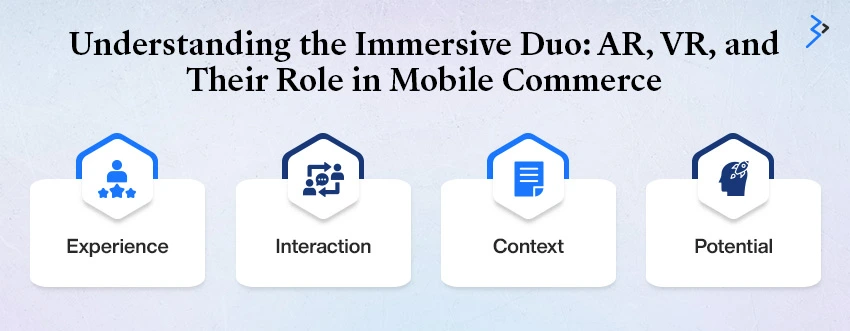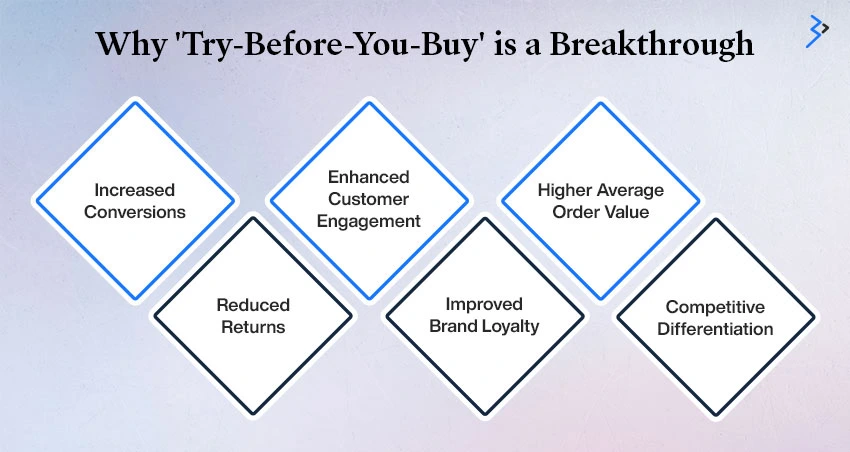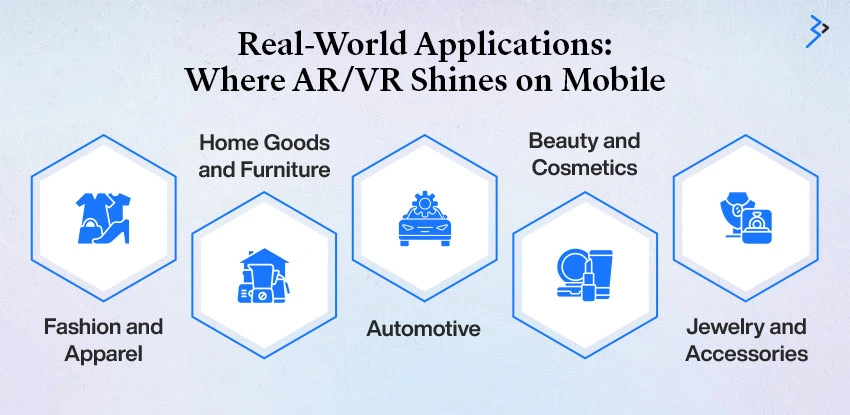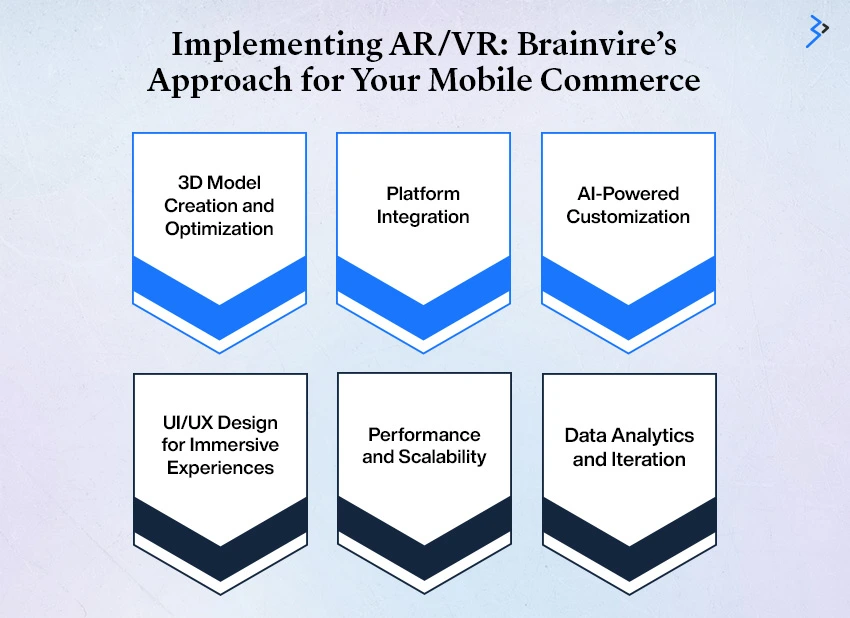Table of contents
A Glimpse into the Past: The Genesis
Understanding the Immersive Duo: AR, VR, and Their Role in Mobile Commerce
The AI Engine: Fueling AR/VR for Smarter Shopping
Why 'Try-Before-You-Buy' is a Breakthrough
Real-World Applications: Where AR/VR Shines on Mobile
Implementing AR/VR: Brainvire’s Approach for Your Mobile Commerce
Frequently Asked Questions
From the desktop era, characterized by static product galleries, to the mobile-first revolution that brought unparalleled convenience to our fingertips, the pursuit of a richer, more engaging customer experience has always been the constant. Today, we’re on the cusp of another seismic shift, one that promises to bridge the gap between digital convenience and physical immersion: Augmented Reality (AR) and Virtual Reality (VR) in mobile commerce, powerfully orchestrated by Artificial Intelligence (AI). This isn’t just about incremental improvements but fundamentally reshaping how consumers interact with products online.
Leading brands are already pioneering this immersive frontier. IKEA’s “Place” app lets millions virtually position furniture in their homes, reducing guesswork and returns. Sephora’s Virtual Artist revolutionized beauty shopping by enabling users to try makeup shades with their phone camera. Even luxury brands like Gucci are leveraging AR for virtual sneaker try-ons, blending digital innovation with high-end appeal.
These are tangible examples of how AI-driven AR/VR retail is addressing the core limitations of online shopping. It moves beyond simple visuals to create rich, interactive, and highly personalized customer journeys that resonate with today’s visually driven, experience-seeking consumers.
A Glimpse into the Past: The Genesis
While AR and VR are experiencing a mainstream resurgence today, their conceptual roots stretch back decades, long before smartphones and powerful graphics cards existed. These weren’t overnight inventions but the culmination of visionary ideas and incremental technological leaps.
For Virtual Reality, one of the earliest pioneers was Morton Heilig. In the late 1950s and early 60s, he envisioned an “Experience Theatre” and went on to create the Sensorama. Patented in 1962, this non-computerized arcade-style machine was designed to immerse a single viewer with stereoscopic visuals, stereo sound, vibrations, and even smells, simulating experiences like a motorcycle ride through New York City. Heilig aimed to create a “cinema of the future” that engaged all the senses.
Although the term itself was coined later, Augmented Reality also has deep historical ties, laying the foundation for today’s advanced Augmented Reality app development services. In 1968, computer scientist Ivan Sutherland and his student Bob Sproull created what is widely considered the first head-mounted display system. Dubbed the “Sword of Damocles” due to its imposing, ceiling-suspended nature, this device displayed simple computer-generated wireframe graphics overlaid onto the user’s view of the real world. Though rudimentary, it laid the foundational groundwork for both AR and VR by demonstrating the potential for combining digital imagery with a real-world perspective.
From these pioneering, often bulky, experiments, the dream of seamlessly blending digital and physical realities has steadily evolved, leading us to the sophisticated, AI-driven mobile experiences we see flourishing in eCommerce today are largely enabled by innovative eCommerce website and app development services.
Understanding the Immersive Duo: AR, VR, and Their Role in Mobile Commerce
While often grouped, AR and VR offer distinct yet complementary experiences:
| Feature | Augmented Reality (AR) | Virtual Reality (VR) |
| Experience | Overlays digital information onto the real world. | Creates an entirely simulated, immersive environment. |
| Viewed Through | Usually a smartphone camera. | Usually requires a headset (e.g., Meta Quest, Apple Vision Pro). |
| Interaction | Integrates virtual objects into your actual environment. | Transports the user to a completely different, virtual world. |
| Examples in Mobile Commerce | Placing virtual furniture in your living room; virtually trying on glasses/makeup. | Walking through a virtual store; exploring a luxury car's interior; attending a virtual fashion show. |
| Context | Highly contextual, blending digital with the real world. | Fully immersive, detaching the user from their real surroundings. |
| Immediate Use for Casual Mobile Shopping | More immediate and accessible due to smartphone ubiquity. | Less immediate for casual shopping due to hardware requirements. |
| Potential | Interactive product visualization in real-time environments. | Deeply immersive experiences, especially for high-value items. |
Both technologies, fundamentally, aim to reduce cognitive load and enhance decision-making by providing richer sensory information than static images or videos ever could. The synergy between them and AI is where the real magic happens, enabling truly personalized and efficient experiences.
Read More - Top VR and AR Development Companies to Watch in 2025
The AI Engine: Fueling AR/VR for Smarter Shopping
AI is the indispensable backbone that elevates AR/VR from mere novelty to powerful commerce tools. It makes these immersive experiences intelligent, personalized, and seamless.
Computer Vision
This is foundational for AR. AI-powered Computer Vision helps a smartphone “understand” its environment – detecting surfaces, dimensions, and lighting conditions. This enables accurate placement of virtual objects and realistic shadow rendering, which is crucial for a convincing virtual try-on experience.
Machine Learning (ML)
ML algorithms analyze vast datasets of user interactions, product dimensions, and even customer preferences. This powers:
- Personalization: Recommending AR/VR experiences based on past Browse, purchases, or visually similar items.
- Sizing Recommendations: ML can predict your best fit for virtual clothing try-on based on body scans (if provided) or even just a few measurements, reducing returns.
- Performance Optimization: Learning how to render complex 3D models efficiently on diverse mobile devices.
Natural Language Processing (NLP)
While not directly visual, NLP can enhance AR/VR experiences by allowing voice commands within virtual environments or providing intelligent product information based on user queries, creating a more conversational AI-powered shopping experience.
Generative AI
Generative AI could soon create custom 3D models from simple text descriptions or even generate personalized virtual showrooms on the fly based on a user’s stated preferences, pushing the boundaries of interactive 3D commerce.
Without AI, AR/VR would be static. With AI, it becomes dynamic, responsive, and brilliant, leading to a smarter, more confident shopping journey.
Why 'Try-Before-You-Buy' is a Breakthrough
The impact of AR and VR in mobile commerce is far-reaching, transforming both consumer behavior and business metrics through advanced mobile commerce development services. The “try-before-you-buy” model isn’t just about fun; it addresses core pain points in online shopping.
- Increased Conversions: Gartner reports that businesses using AR have seen conversion rates increase by up to 200%. When customers can visualize products accurately, their purchase confidence skyrockets.
- Reduced Returns: A major headache for eCommerce, returns can be significantly mitigated. Products like furniture or apparel often get returned because they don’t fit or look as expected. AR/VR helps solve this. Companies like Warby Parker (glasses) have effectively used AR to reduce returns related to fit and style.
- Enhanced Customer Engagement: AR/VR experiences are inherently more interactive and memorable than traditional product pages. Users spend more time engaging with products, leading to deeper brand connections. Mobile AR shopping apps see longer session times.
- Improved Brand Loyalty: A superior shopping experience builds loyalty. Brands that offer innovative tools stand out in a crowded market.
- Higher Average Order Value (AOV): Immersive experiences encourage customers to explore more products and make more confident purchases, potentially leading to larger baskets.
- Competitive Differentiation: As still an emerging technology for many sectors, early adopters gain a significant edge, positioning themselves as innovators.
Impact of AR/VR in Mobile Commerce
| Benefit | Description | Impact for Business |
| Higher Conversion Rates | Customers buy more confidently after visualizing products accurately. | Direct increase in sales revenue. |
| Lower Return Rates | Fewer returns due to better fit and visual expectations. | Reduced operational costs, improved profitability. |
| Increased Engagement | Interactive experiences lead to longer user sessions and deeper interaction. | Stronger brand connection, improved customer stickiness. |
| Enhanced Personalization | AI customizes product views and recommendations to individual users. | More relevant offerings, higher customer satisfaction. |
| Competitive Advantage | Early adoption positions brands as innovative leaders. | Market differentiation, attraction of tech-savvy customers. |
| Global Accessibility | Virtual experiences transcend physical showrooms, reaching wider audiences. | Expanded market reach, democratized access to luxury items. |
Real-World Applications: Where AR/VR Shines on Mobile
The “Snap and Shop” revolution isn’t theoretical; it’s happening across various sectors:
- Fashion and Apparel (Virtual Try-On): This is probably the most natural fit. Apps like Snapchat (with AR lenses for clothing), Sephora’s Virtual Artist (makeup), and retailers like ASOS are letting customers try on everything from sneakers to sunglasses virtually. This addresses the “Does it suit me?” question directly.
- Home Goods and Furniture (AR for Home Decor): IKEA Place, Wayfair, and Amazon’s AR View allow users to virtually place furniture and decor items in their actual rooms, checking size, style, and fit before buying. This significantly reduces buyer’s remorse and logistical headaches.
- Automotive: While not ‘snapping,’ AR apps can let you customize a car’s color, wheels, or interior on your driveway, offering an interactive showroom experience without leaving home.
- Beauty and Cosmetics: Virtual try-ons for lipstick, eyeshadow, and even hair colors help customers experiment with confidence, boosting sales and reducing returns on hygiene products.
- Jewelry and Accessories: See how a watch looks on your wrist or earrings frame your face with realistic AR overlays.
Implementing AR/VR: Brainvire’s Approach for Your Mobile Commerce
Integrating AR/VR into mobile commerce requires more than just a flashy feature; it demands a strategic approach, robust infrastructure, and deep technical expertise. As your eCommerce solutions provider, Brainvire focuses on a holistic implementation:
- 3D Model Creation and Optimization: The core of any AR/VR experience. We specialize in creating high-fidelity, optimized 3D models of your products. These models must be lightweight enough for mobile performance but detailed enough for realism.
- Platform Integration: Seamlessly integrating AR/VR capabilities into your existing eCommerce platform (Shopify, Magento, Salesforce Commerce Cloud, etc.) or developing custom solutions. This includes leveraging SDKs like Apple’s ARKit and Google’s ARCore for native mobile app experiences.
- AI-Powered Customization: Implementing AI/ML algorithms for personalized shopping experiences. This can range from intelligent product recommendations based on visual preferences to advanced sizing guides for apparel.
- UI/UX Design for Immersive Experiences: Designing intuitive user interfaces that guide customers through AR/VR interactions, ensuring a smooth and engaging “try-before-you-buy” journey. This includes clear calls to action and easy switching between real and augmented views.
- Performance and Scalability: Ensuring the AR/VR solutions are optimized for various mobile devices and network conditions, delivering a consistent and fast experience that scales with your business growth. This is crucial for mobile AI shopping.
- Data Analytics and Iteration: Implementing robust analytics to track user engagement with AR/VR features, understanding what works, and refining the experience based on real user data.
The future of online retail is visually intuitive. By embracing AR and VR, businesses can unlock new levels of customer engagement, reduce friction in the buying process, and significantly boost their bottom line. It’s time to move beyond static images and let your customers truly ‘snap and shop’ confidently.
Frequently Asked Questions
1) What is the difference between AR and VR in eCommerce?
AR (Augmented Reality) overlays digital information onto your real-world view, typically via a smartphone camera, allowing you to see virtual products in your actual environment (e.g., placing a virtual sofa in your living room). VR (Virtual Reality) creates an entirely simulated, immersive digital environment that transports you to a different world, usually requiring a headset (e.g., “walking” through a virtual store).
2) How does AI enhance AR and VR experiences in mobile commerce?
AI is crucial for making AR/VR intelligent. Computer Vision allows devices to understand real-world environments for accurate virtual object placement. Machine Learning powers personalization, smart sizing recommendations, and optimizes performance. AI ensures the “try-before-you-buy” experience is realistic, relevant, and seamlessly integrated into mobile AI shopping.
3) What are the key benefits for businesses adopting AR/VR in their mobile commerce strategy?
Adopting AR/VR can significantly increase conversion rates (up to 200% reported), drastically reduce product returns (especially for items like furniture and apparel), boost customer engagement, enhance brand loyalty, and provide a strong competitive differentiation. It creates a more confident and satisfying shopping experience for customers.
4) What types of products benefit most from AR/VR ‘try-before-you-buy’ features?
Products where visualization, fit, or placement are critical benefit most. This includes fashion and apparel (virtual clothing try-on, glasses), home goods and furniture (AR for home decor, visualizing items in a room), beauty and cosmetics (virtual makeup try-on), and jewelry/accessories. It helps customers overcome the lack of physical interaction in online shopping.
5) What should a business consider when implementing AR/VR in their eCommerce?
Key considerations include creating high-quality, optimized 3D product models, ensuring seamless integration with existing eCommerce platforms, leveraging AI for personalization, designing intuitive user interfaces, and planning for performance and scalability across various mobile devices. Partnering with an experienced eCommerce solutions provider is vital for successful implementation.
Related Articles
Digital Transformation
Hyper-Personalized Banking: Driving Customer Loyalty and Engagement with AI-Powered Adobe Experiences
Digital Transformation
Leveraging 3rd Party LLMs: A Guide to Commercial AI Platforms
Digital Transformation
AI-Driven Security: Protecting Your eCommerce App and Customer Data in an Evolving Threat Landscape







